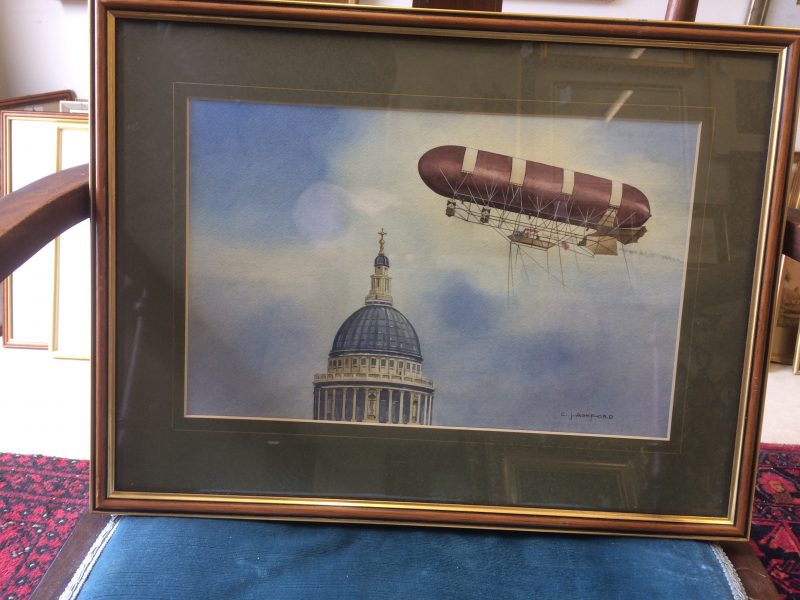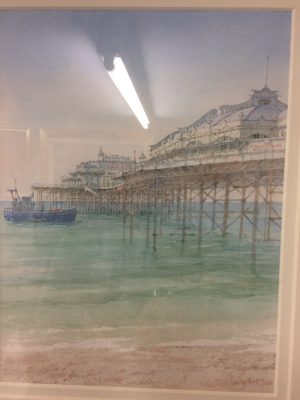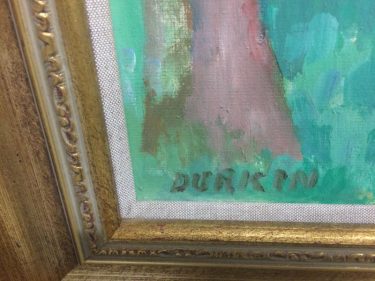Description
A typical watercolour by a master of the flying machine painting. The picture depicts an airship flying over a domed church (possibly St Paul’s Cathedral) with The Union Jack flying to the rear of the craft with a trail of exhaust gases visible. It is signed to the bottom right corner and has a Guild of Aviation Artists label to the reverse giving the title of the painting as “Farnborough’s First Airship”. The painting by renowned aviation artist, Colin J Ashford, is framed, mounted and glazed with the frame measuring 47 x 36 cm (18.5″ x 14″). The painting itself measures 34 x 23 cm (13.5″ x 9″).
Colin James Ashford British born 1919
Ashford was born in Ackworth, Yorkshire in 1919 he attended Ackworth Quaker School wherehis teaches confessed to not being able to teach him anything about drawing. At the age of 14 he won a junior painting exhibition which got him onto a four year course at Wakefield School of Art followed by a further three years at Glasgow School of Art, winning many exhibitions and prizes along the way. He fought in the Second World War sustaining injuries during a battle against two Panzer divisions whilst trying to hold the Allied front in Belgium. He returned home with bullet wounds to the legs and severe shell shock. Once recovered he pursued his artistic career and became one of the founding members of The Guild of Aviation Artists and went on to be elected Vice president of the society in 2010. He has paintings hanging in The Royal Air Force Museum and The Yorkshire Air Museum.
Excerpt from a newspaper article about this painting….
“Airship History…And A Local Tale Of Flying Machines.
The painting I have selected this week offers us the story of a piece of local history. It is by Colin J Ashford, the well-known aviation artist, and is entitled “Farnborough’s First Airship”. A stunningly accurate painting that depicts an airship flying over St Paul’s Cathedral in London. It is a painting that is an historical record of the first long distance flight of an airship in Britain and it took off from Farnborough Airfield.
Farnborough Airport, as it is now known, was created as His Majesty’s Balloon Factory. It was quickly established as an early ballooning airfield; indeed, it is thought that the beginnings of The RAF can be traced back to Farnborough. In the early days it was used as a place to train engineers how to fly a balloon and developed into the centre of the British search for powered flight, which involved one Samuel Cody (more of him in a moment).
On the 10th September in 1907 The British Army Dirigible No.1, an airship called “The Nulli Secundus” (latin for second to none), took off and flew for 3 miles before engine failure curtailed its flight. However, a further attempt was made and at 11am on 5th October 1907 it took off from Farnborough and crewed by its builders Colonel John Capper and Samuel Cody, along with Lieutenant Waterlow of The Royal Engineers, it flew over Whitehall, Buckingham Palace and circled St Paul’s Cathedral before heading back towards home. It is precisely this flight that is the subject of this painting and there are two pictures to go with the story this week, one is the painting itself the other is an early photographic postcard of the day it took off from Farnborough that I found during my research into the historical accuracy of the painting.
About the same time this flight was happening Samuel Cody, the famous American showman and aviator, who had come over to assist the British in the development of our own “Flying Machines”, was also developing a prototype “Aeroplane”. Only one year later (5th October 1908) the first powered flight of a flying machine in Britain occurred when Cody took off from Farnborough in his British Army Aeroplane No.1.
The artist of this painting is Colin James Ashford. He was born in March 1919 in Ackworth, Yorkshire. He had a real talent for painting and drawing and won a scholarship to go to The Wakefield School of Art for four years. He followed this up with a further three years at The Glasgow school of Art from 1937 – 1939, where he won many prizes for drawing and painting. He then joined the First Battalion Scottish Light Infantry and was sent over to France as part of the Expeditionary Force sent to shore up the Allied Front following Belgium’s surrender. Ashford’s battalion came under attack from a superior force including two Panzer divisions but they dug in and held out for 24 hours before having to retreat. Ashford returned home after spending two days on the beach at Dunkirk. Following three months of treatment he went back into battle with The Royal Engineers in North Africa and Italy. Following the end of the war he worked in publishing for many years whilst maintaining his painting. In 1971 the Guild of Aviation Artists was set up with Ashford being one of the founder members and in 2010 he was elected as the Vice President of that organisation which now represents over 500 specialist artists worldwide. His paintings hang in The Royal Air Force Museum, the Yorkshire Air Museum, Hendon RAF Museum and many other museums and galleries around the world.”



















